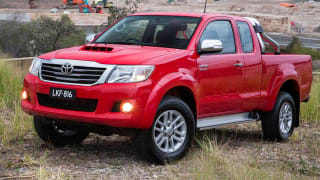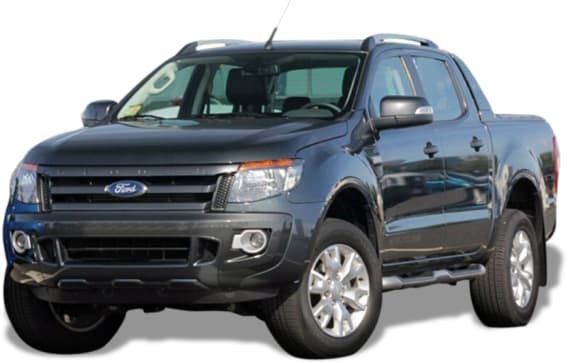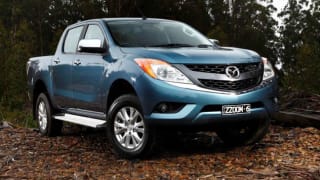The dual-cab four-wheel drive ute has become the multi-tool of the automotive world. The good ones can pull, carry, conquer and cruise in equal measures, and if you can handle their size, they can make a pretty useful daily companion.
Ford’s Ranger is a better tool than most, and the top-of-the-heap Wildtrak brings a liberal dose of visual flare and added luxuries to make it the envy of any worksite, campsite or boat ramp.
Value
Priced serendipitously close to that other bloke bucket list item, the $60,990 HSV Clubsport, the $59,390 Wildtrak (auto) comes with every toy you could wish for in a four wheel drive dual cab.
Explore the 2013 Ford Ranger range
Features include mesh and leatherette embroidered seats with heaters up front and eight-way driver’s adjustment, climate control, a five inch multimedia screen with satnav and Bluetooth, and a chilled centre console designed to accommodate carry a six pack.
It’s not cheap though, with the Wildtrak outpricing all of its direct rivals aside from the $61,490 Volkswagen Amarok Ultimate TDI 420, which outclasses the Wildtrak with genuine leather trim, but lacks the Ford’s satnav and low range gearing.
Design
Beyond the lesser Ranger models’ already handsome design, the Wildtrak adds aggressive front bumper detailing, an aerodynamic sport bar and retractable tonneau adorning the tray, tubular sidesteps, and bigger 18 inch alloys.
Despite such garnish, the Ranger 4x4’s off road credentials are not diminished and the Wildtrak maintains an impressive 800mm wading depth, low range transfer case, hill descent control and a rear diff lock.
The 2200kg Wildtrak is the heaviest Ranger of all, but maintains a useful one tonne payload, standard tray liner and the capability to tow three and a half tonnes with the standard towbar.
In the back, there’s plenty of room for three adults, and the seatback is set at a comfortable angle for a dual cab. Beyond bottle holders in each door, numerous cavities and three 12V sockets, there’s a pair of storage bins underneath the rear seat base, and more room behind the folding backrest.
Engine/Transmission
The Wildtrak’s 3.2 litre, five cylinder turbodiesel puts out a very healthy 147kW and 470Nm, and the $2000 optional six-speed auto does an excellent job of embracing the engine’s 1500-2750rpm max torque band.
The Wildtrak’s official combined fuel figure is 9.6L/100km, but we managed a genuine 9.2L/100km figure from one 80L tank, traversing the Blue Mountains west of Sydney twice, on bitumen and dirt, dabbling in low-range, with a few hours of Sydney peak-hour traffic thrown in for good measure. What made this figure even more impressive was the fact that the Wildtrak was laden to near GVM for much of the journey.
Safety
Like all PX Rangers, the Wildrack carries a five star safety rating with dual front and side and curtain airbags for front seat occupants, along with ABS, traction and stability control with integrated trailer sway assist. The Wildtrak is also the only Ranger available with a reversing camera, which teams well with the standard rear parking sensors and huge door mirrors to help deal with its 5.4m overall length.
Driving
To describe the Ranger’s drive experience as car-like would not be fair, as there will always be some trade-off in a vehicle rated to carry one tonne, tow 3.5 tonnes, with rear leaf springs keeping it all above the tarmac. Stepping straight from a passenger car, the Ranger still feels like a ute over bumps, and the steering is heavier than the modern car norm.
However, the Ranger does passenger comfort better than most utes, with dampened body mounts and a feeling of solidity matched only by the Amarok.
The double wishbone front suspension geometry responds well to direction changes, particularly over bumps, and the handling is nicely predictable over gravel roads. Around town, the 3.2 litre’s outputs see it ready for most traffic light grands prix, and it comfortably maintains highway pace on steep inclines, and does so with sufficient comfort to encourage long-distance touring.











